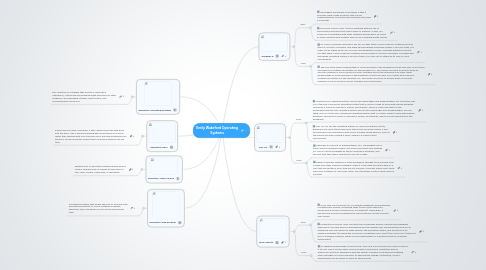
1. Definition: Operating Systems
1.1. the collection of software that directs a computer's operations, controlling and scheduling the execution of other programs, and managing storage, input/output, and communication resources.
2. Definition: Open Source
2.1. pertaining to or denoting software whose source code is available free of charge to the public to use, copy, modify, sublicense, or distribute.
3. Definition: Web Browser
3.1. a software program that allows the user to find and read encoded documents in a form suitable for display, especially such a program for use on the World Wide Web.
4. Definition: RAM
4.1. Every time you open a program, it gets loaded from the hard drive into the RAM. This is because reading data from the RAM is much faster than reading data from the hard drive. Running programs from the RAM of the computer allows them to function without any lag time.
5. Windows 8
5.1. pros
5.1.1. The biggest advantage of Windows is that it provides ready-made solutions that can be implemented by just about anyone who’s ever used a computer.
5.1.2. Microsoft Office is also 100% compatible with any file or document produced in the office space in America. In fact, MS Office isn’t compatible with other software and systems, so much as other software and systems strive to be compatible with Office!
5.2. cons
5.2.1. Of course, Windows detractors will tell you that there is more need for software services when it comes to Windows. And while this worldwide operating system is far from trash, it is often not as stable as its Mac or Linux counterpartsOf course, Windows detractors will tell you that there is more need for software services when it comes to Windows. And while this worldwide operating system is far from trash, it is often not as stable as its Mac or Linux counterparts.
5.2.2. The only other major disadvantage of using Windows in the workplace is that over 95% of all viruses and malicious software are written for the Windows OS. This means you have to double-down all security measures if you’re using Microsoft software across the boardThe only other major disadvantage of using Windows in the workplace is that over 95% of all viruses and malicious software are written for the Windows OS. This means you have to double-down all security measures if you’re using Microsoft software across the board.
6. Mac OS
6.1. pros
6.1.1. Using the Mac operating system has its own advantages and disadvantages. For one thing, Mac OS is the only commercial operating system that is custom-made to work with Apple’s hardware. This gives it a level of efficiency, power, and stability, which is most important for the workplaceUsing the Mac operating system has its own advantages and disadvantages. For one thing, Mac OS is the only commercial operating system that is custom-made to work with Apple’s hardware. This gives it a level of efficiency, power, and stability, which is most important for the workplace.
6.1.2. Mac OS X is still the operating system of choice for graphic artists, designers and most others who work with visual and audio media. It also synchronizes user information well across multiple Apple devices, such as the iPhone and iPad, making it easily usable in a mobile office environment.
6.2. cons
6.2.1. Apple has its own set of disadvantages, too. The biggest one is price: Apple computers simply cost much more than your average PC. This is offset somewhat by those computers’ durability, and the fact that they take a long time to go out of date.
6.2.2. Apple’s computer platform is often mistakenly thought to be immune from viruses and other malicious software. While it is true that you rarely hear of a Mac that has gotten a virus, they are not immune. Criminals simply don’t write malicious software for Macs very often. Don’t be taken in with a false sense of security!
7. Linux Ubuntu
7.1. pros
7.1.1. Linux, was once the play toy of computer hobbyists and workhorse of behind-the-scenes computing tasks (most of the internet is served up by servers running Linux, for example). These days, it has become a home computing and office platform for the common user as well.
7.1.2. Distributions such as Linux Mint and the increasingly popular Ubuntu were designed especially to be easy and non-threatening for the average user. Implementing Linux on an enterprise level can add up to huge savings: the operating system, and almost all of its available software (including the Microsoft-compatible Libre Office) are 100% free. (There’s no lack of available software, either–as you might expect of a platform built by computer enthusiasts!)
7.2. cons
7.2.1. Its biggest disadvantage is that its end-users and office workers are often scared of it at first. This is usually easily overcome with a morning of orientation and an afternoon’s worth of experience with the system. Perhaps more difficult is getting other managers or board members to approve the change. Fortunately, most IT departments will be happy to back up the decision!
